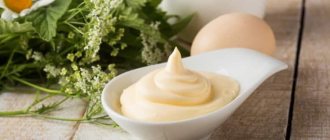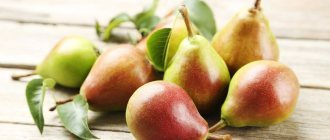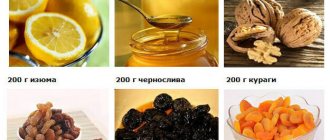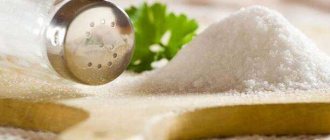Healthy eating means eating not only tasty and satisfying foods, but also healthy foods. Peas fully meet these requirements. This culture contains a number of elements valuable to the body, which determine its beneficial properties. Peas are recommended for all categories of people, especially useful for pregnant women. Despite its relatively high calorie content, it is widely used in dietary nutrition. There are also a number of contraindications in which the use of the culture is prohibited or limited.
Nutritional and energy value, composition
Content of nutrients in fresh green peas (BJU per 100 g of product):
- Proteins - 5.4 g;
- Fats - 0.4 g;
- Carbohydrates - 14.5 g.
The energy value of the product is 81 kcal (339 kJ).
Depending on the category of peas, the energy and nutritional value can vary:
| Type of peas | Calorie content (calorie content per 100 g) | BZHU content (grams per 100 g) |
| Dry (dried) | 297 | 20,4/2/53,4 |
| Boiled in water | 59,8 | 5,9/0/9,1 |
| Boiled in puree | 35,4 | 2,15/0,19/6,8 |
| Canned | 55,7 | 3,58/0,13/9,9 |
| Fried | 170 | 5,1/13/8,4 |
The culture includes a number of vitamins, each of which is important for the health and full development of the human body:
| Vitamin | Contents per 100 g of product |
| A (retinol) | 38 mcg |
| β-carotene | 449 mcg |
| B1 (thiamine) | 0.3 mg |
| B2 (riboflavin) | 0.1 mg |
| B3 (niacin) | 2.1 mg |
| B5 (pantothenic acid) | 0.1 mg |
| B6 (pyridoxine) | 0.2 mg |
| B9 (folacin) | 65 mcg |
| C (ascorbic acid) | 40 mg |
The product is also rich in minerals and trace elements necessary to maintain health:
| Element | Content (mg per 100 g of product) |
| Calcium | 25 |
| Iron | 1,5 |
| Magnesium | 33 |
| Phosphorus | 108 |
| Potassium | 244 |
| Zinc | 1,2 |
Due to its high protein content, peas are consumed by some categories of people as an alternative to meat, for example, vegetarians or believers during fasting.
Brain varieties of the plant are considered more tasty than table varieties. This is due to the increased content of starch and sugars. However, as brain peas ripen, the level of sugars in brain peas decreases.
Calorie content Boiled peas. Chemical composition and nutritional value.
Nutritional value and chemical composition of “Boiled peas”.
The table shows the nutritional content (calories, proteins, fats, carbohydrates, vitamins and minerals) per 100 grams of edible portion.
| Nutrient | Quantity | Norm** | % of the norm in 100 g | % of the norm in 100 kcal | 100% normal |
| Calorie content | 118 kcal | 1684 kcal | 7% | 5.9% | 1427 g |
| Squirrels | 8.34 g | 76 g | 11% | 9.3% | 911 g |
| Fats | 0.39 g | 56 g | 0.7% | 0.6% | 14359 g |
| Carbohydrates | 12.8 g | 219 g | 5.8% | 4.9% | 1711 g |
| Alimentary fiber | 8.3 g | 20 g | 41.5% | 35.2% | 241 g |
| Water | 69.49 g | 2273 g | 3.1% | 2.6% | 3271 g |
| Ash | 0.68 g | ~ | |||
| Vitamins | |||||
| beta carotene | 0.004 mg | 5 mg | 0.1% | 0.1% | 125000 g |
| Vitamin B1, thiamine | 0.19 mg | 1.5 mg | 12.7% | 10.8% | 789 g |
| Vitamin B2, riboflavin | 0.056 mg | 1.8 mg | 3.1% | 2.6% | 3214 g |
| Vitamin B4, choline | 32.8 mg | 500 mg | 6.6% | 5.6% | 1524 g |
| Vitamin B5, pantothenic | 0.595 mg | 5 mg | 11.9% | 10.1% | 840 g |
| Vitamin B6, pyridoxine | 0.048 mg | 2 mg | 2.4% | 2% | 4167 g |
| Vitamin B9, folates | 65 mcg | 400 mcg | 16.3% | 13.8% | 615 g |
| Vitamin C, ascorbic acid | 0.4 mg | 90 mg | 0.4% | 0.3% | 22500 g |
| Vitamin E, alpha tocopherol, TE | 0.03 mg | 15 mg | 0.2% | 0.2% | 50000 g |
| Vitamin K, phylloquinone | 5 mcg | 120 mcg | 4.2% | 3.6% | 2400 g |
| Vitamin RR, NE | 0.89 mg | 20 mg | 4.5% | 3.8% | 2247 g |
| Macronutrients | |||||
| Potassium, K | 362 mg | 2500 mg | 14.5% | 12.3% | 691 g |
| Calcium, Ca | 14 mg | 1000 mg | 1.4% | 1.2% | 7143 g |
| Magnesium, Mg | 36 mg | 400 mg | 9% | 7.6% | 1111 g |
| Sodium, Na | 2 mg | 1300 mg | 0.2% | 0.2% | 65000 g |
| Sera, S | 83.4 mg | 1000 mg | 8.3% | 7% | 1199 g |
| Phosphorus, P | 99 mg | 800 mg | 12.4% | 10.5% | 808 g |
| Microelements | |||||
| Iron, Fe | 1.29 mg | 18 mg | 7.2% | 6.1% | 1395 g |
| Manganese, Mn | 0.396 mg | 2 mg | 19.8% | 16.8% | 505 g |
| Copper, Cu | 181 mcg | 1000 mcg | 18.1% | 15.3% | 552 g |
| Selenium, Se | 0.6 mcg | 55 mcg | 1.1% | 0.9% | 9167 g |
| Zinc, Zn | 1 mg | 12 mg | 8.3% | 7% | 1200 g |
| Digestible carbohydrates | |||||
| Mono- and disaccharides (sugars) | 2.9 g | max 100 g | |||
| Essential amino acids | |||||
| Arginine* | 0.744 g | ~ | |||
| Valin | 0.394 g | ~ | |||
| Histidine* | 0.203 g | ~ | |||
| Isoleucine | 0.344 g | ~ | |||
| Leucine | 0.598 g | ~ | |||
| Lysine | 0.602 g | ~ | |||
| Methionine | 0.085 g | ~ | |||
| Threonine | 0.296 g | ~ | |||
| Tryptophan | 0.093 g | ~ | |||
| Phenylalanine | 0.384 g | ~ | |||
| Nonessential amino acids | |||||
| Alanin | 0.367 g | ~ | |||
| Aspartic acid | 0.984 g | ~ | |||
| Glycine | 0.371 g | ~ | |||
| Glutamic acid | 1.426 g | ~ | |||
| Proline | 0.344 g | ~ | |||
| Serin | 0.367 g | ~ | |||
| Tyrosine | 0.242 g | ~ | |||
| Cysteine | 0.127 g | ~ | |||
| Saturated fatty acids | |||||
| Saturated fatty acids | 0.054 g | max 18.7 g | |||
| 12:0 Lauric | 0.001 g | ~ | |||
| 14:0 Miristinovaya | 0.001 g | ~ | |||
| 16:0 Palmitinaya | 0.042 g | ~ | |||
| 18:0 Stearic | 0.01 g | ~ | |||
| Monounsaturated fatty acids | 0.081 g | min 16.8 g | 0.5% | 0.4% | |
| 18:1 Oleic (omega-9) | 0.077 g | ~ | |||
| 20:1 Gadoleic (omega-9) | 0.003 g | ~ | |||
| Polyunsaturated fatty acids | 0.165 g | from 11.2 to 20.6 g | 1.5% | 1.3% | |
| 18:2 Linolevaya | 0.137 g | ~ | |||
| 18:3 Linolenic | 0.028 g | ~ | |||
| Omega-3 fatty acids | 0.028 g | from 0.9 to 3.7 g | 3.1% | 2.6% | |
| Omega-6 fatty acids | 0.137 g | from 4.7 to 16.8 g | 2.9% | 2.5% |
The energy value of boiled peas is 118 kcal.
Primary Source: Created in the application by the user. Read more.
** This table shows the average levels of vitamins and minerals for an adult. If you want to know the norms taking into account your gender, age and other factors, then use the “My Healthy Diet” application.
Beneficial features
The rich chemical composition determines the following beneficial properties of the product:
- removing excess fluid from the body, relieving swelling;
- combating the consequences of anemia;
- elimination of constipation, normalization of the functioning of the gastrointestinal tract;
- treatment of eczema and other skin diseases;
- lowering blood cholesterol levels;
- eliminating the risk of developing iodine deficiency in the fetus;
- prevention of asthma, elimination of complications during attacks;
- assistance in the treatment of oncology, tuberculosis;
- restoration of visual acuity, relieving eye fatigue;
- eliminating heartburn.
For men
Peas have a positive effect on the prostate. In turn, this has a beneficial effect on the functioning of the entire genitourinary system. Consumption of the culture can increase potency and stimulate sexual activity. Due to folic acid, it is possible to increase the number and quality of sperm.
Due to its nutritional value and satiety, the product is recommended for strength sports and heavy physical work.
Peas stimulate muscle function and accelerate the growth of muscle mass.
For women
One of the most important components of the product for women is folic acid. This element slows down the aging process of the body and is responsible for the normal condition and functioning of female organs.
Peas have a positive effect on the condition of the skin. This effect can be achieved through comprehensive cleansing of the body and solving various skin problems.
The product is able to saturate the body with vital hemoglobin. This is especially important during the menstrual cycle, when the content of this substance in the blood drops to critical levels.
Peas contain a large amount of vitamins, proteins and amino acids, which makes the product almost indispensable for expectant mothers. The culture allows you to normalize blood pressure and lower cholesterol levels.
Other beneficial properties for expectant mothers:
- Vitamin C helps strengthen the body's defenses;
- folic acid can significantly reduce the risk of developing fetal defects during pregnancy;
- Calcium contained in peas is necessary for the formation and strengthening of the baby’s skeletal system, as well as for improving the condition of the mother’s body.
The product helps you fall asleep more firmly and quickly, fights insomnia and sleep disorders, which are often found in pregnant women.
At the same time, peas belong to the category of heavy foods, as a result of which expectant mothers are not recommended to consume them in dry form. The culture must first be soaked in cool water and washed thoroughly - only after that it becomes suitable for consumption.
A few days before giving birth, expectant mothers should stop taking peas. This is due to the fact that the product causes increased gas formation in the intestines. For the same reason, peas are not recommended for consumption throughout the entire period of breastfeeding.
For children
In terms of protein content, peas are comparable to beef, which makes the product an important component of baby nutrition. At the same time, the protein contained in the culture is quickly absorbed by the child’s body.
Another important ingredient is thiamine. This substance has the following positive effects on the child’s body:
- activates the growth of the child;
- increases appetite;
- accelerates the development of the muscular system;
- saturates the body with energy.
Peas contain significant amounts of vitamin C, which helps strengthen the immune system and protect against respiratory diseases.
Pea porridge is especially useful for schoolchildren. Thanks to its use, it is possible to increase concentration, improve memory and vision.
Rules for use and use in diets
In terms of its energy value, peas do not belong to the category of low-calorie products. Despite this, it has a number of beneficial properties that are important for people who are struggling with excess weight:
- cleanses the body of excess fluid, thereby reducing body volume and eliminating cellulite;
- does not accumulate in the body in the form of fat deposits;
- strengthens the muscle frame;
- removes waste and toxins.
The simplest way to lose weight is to soak dry peas in cold water for 12 hours and then grind them in a meat grinder. The resulting mass is consumed in several tablespoons throughout the day. The treatment course lasts 1-1.5 weeks. Upon completion, weight will decrease and intestinal functioning will return to normal.
When using the culture for dietary purposes, you should completely refrain from consuming salt and sugar.
The permissible intake of fresh peas is 200 g per day. The boiled product as part of various salads, cereals, etc. is not recommended to consume more than 100 g per day.
Calorie content Split peas, boiled, without salt. Chemical composition and nutritional value.
Nutritional value and chemical composition “Split peas, boiled, without salt.”
The table shows the nutritional content (calories, proteins, fats, carbohydrates, vitamins and minerals) per 100 grams of edible portion.
| Nutrient | Quantity | Norm** | % of the norm in 100 g | % of the norm in 100 kcal | 100% normal |
| Calorie content | 118 kcal | 1684 kcal | 7% | 5.9% | 1427 g |
| Squirrels | 8.34 g | 76 g | 11% | 9.3% | 911 g |
| Fats | 0.39 g | 56 g | 0.7% | 0.6% | 14359 g |
| Carbohydrates | 12.8 g | 219 g | 5.8% | 4.9% | 1711 g |
| Alimentary fiber | 8.3 g | 20 g | 41.5% | 35.2% | 241 g |
| Water | 69.49 g | 2273 g | 3.1% | 2.6% | 3271 g |
| Ash | 0.68 g | ~ | |||
| Vitamins | |||||
| beta carotene | 0.004 mg | 5 mg | 0.1% | 0.1% | 125000 g |
| Vitamin B1, thiamine | 0.19 mg | 1.5 mg | 12.7% | 10.8% | 789 g |
| Vitamin B2, riboflavin | 0.056 mg | 1.8 mg | 3.1% | 2.6% | 3214 g |
| Vitamin B4, choline | 32.8 mg | 500 mg | 6.6% | 5.6% | 1524 g |
| Vitamin B5, pantothenic | 0.595 mg | 5 mg | 11.9% | 10.1% | 840 g |
| Vitamin B6, pyridoxine | 0.048 mg | 2 mg | 2.4% | 2% | 4167 g |
| Vitamin B9, folates | 65 mcg | 400 mcg | 16.3% | 13.8% | 615 g |
| Vitamin C, ascorbic acid | 0.4 mg | 90 mg | 0.4% | 0.3% | 22500 g |
| Vitamin E, alpha tocopherol, TE | 0.03 mg | 15 mg | 0.2% | 0.2% | 50000 g |
| Vitamin K, phylloquinone | 5 mcg | 120 mcg | 4.2% | 3.6% | 2400 g |
| Vitamin RR, NE | 0.89 mg | 20 mg | 4.5% | 3.8% | 2247 g |
| Macronutrients | |||||
| Potassium, K | 362 mg | 2500 mg | 14.5% | 12.3% | 691 g |
| Calcium, Ca | 14 mg | 1000 mg | 1.4% | 1.2% | 7143 g |
| Magnesium, Mg | 36 mg | 400 mg | 9% | 7.6% | 1111 g |
| Sodium, Na | 2 mg | 1300 mg | 0.2% | 0.2% | 65000 g |
| Sera, S | 83.4 mg | 1000 mg | 8.3% | 7% | 1199 g |
| Phosphorus, P | 99 mg | 800 mg | 12.4% | 10.5% | 808 g |
| Microelements | |||||
| Iron, Fe | 1.29 mg | 18 mg | 7.2% | 6.1% | 1395 g |
| Manganese, Mn | 0.396 mg | 2 mg | 19.8% | 16.8% | 505 g |
| Copper, Cu | 181 mcg | 1000 mcg | 18.1% | 15.3% | 552 g |
| Selenium, Se | 0.6 mcg | 55 mcg | 1.1% | 0.9% | 9167 g |
| Zinc, Zn | 1 mg | 12 mg | 8.3% | 7% | 1200 g |
| Digestible carbohydrates | |||||
| Mono- and disaccharides (sugars) | 2.9 g | max 100 g | |||
| Essential amino acids | |||||
| Arginine* | 0.744 g | ~ | |||
| Valin | 0.394 g | ~ | |||
| Histidine* | 0.203 g | ~ | |||
| Isoleucine | 0.344 g | ~ | |||
| Leucine | 0.598 g | ~ | |||
| Lysine | 0.602 g | ~ | |||
| Methionine | 0.085 g | ~ | |||
| Threonine | 0.296 g | ~ | |||
| Tryptophan | 0.093 g | ~ | |||
| Phenylalanine | 0.384 g | ~ | |||
| Nonessential amino acids | |||||
| Alanin | 0.367 g | ~ | |||
| Aspartic acid | 0.984 g | ~ | |||
| Glycine | 0.371 g | ~ | |||
| Glutamic acid | 1.426 g | ~ | |||
| Proline | 0.344 g | ~ | |||
| Serin | 0.367 g | ~ | |||
| Tyrosine | 0.242 g | ~ | |||
| Cysteine | 0.127 g | ~ | |||
| Saturated fatty acids | |||||
| Saturated fatty acids | 0.054 g | max 18.7 g | |||
| 12:0 Lauric | 0.001 g | ~ | |||
| 14:0 Miristinovaya | 0.001 g | ~ | |||
| 16:0 Palmitinaya | 0.042 g | ~ | |||
| 18:0 Stearic | 0.01 g | ~ | |||
| Monounsaturated fatty acids | 0.081 g | min 16.8 g | 0.5% | 0.4% | |
| 18:1 Oleic (omega-9) | 0.077 g | ~ | |||
| 20:1 Gadoleic (omega-9) | 0.003 g | ~ | |||
| Polyunsaturated fatty acids | 0.165 g | from 11.2 to 20.6 g | 1.5% | 1.3% | |
| 18:2 Linolevaya | 0.137 g | ~ | |||
| 18:3 Linolenic | 0.028 g | ~ | |||
| Omega-3 fatty acids | 0.028 g | from 0.9 to 3.7 g | 3.1% | 2.6% | |
| Omega-6 fatty acids | 0.137 g | from 4.7 to 16.8 g | 2.9% | 2.5% |
The energy value of split peas, boiled, without salt is 118 kcal.
- cup = 196 g (231.3 kcal)
- tbsp = 12.2 g (14.4 kcal)
Primary source: USDA National Nutrient Database for Standard Reference. Read more.
** This table shows the average levels of vitamins and minerals for an adult. If you want to know the norms taking into account your gender, age and other factors, then use the “My Healthy Diet” application.
Contraindications
In order not to cause harm to health, you should refrain from eating peas if you have the following diseases and problems with the body:
- individual intolerance to the product, allergic reactions;
- age under 3 years;
- old age (due to a weakened digestive system);
- lactation period;
- nephritis;
- cholecystitis;
- type 1 diabetes;
- thrombophlebitis.
For some diseases, the use of peas is not completely prohibited, but is significantly limited:
- For gout, you can eat boiled peas in small quantities.
- In case of pathologies of the kidneys and liver, the product is allowed to be eaten only in rare cases.
- Dry and boiled peas should be used with caution if there are disturbances in the functioning of the gastrointestinal tract associated with high acidity.
- For pancreatitis, you can eat a certain amount of sprouted peas. It is believed that the product in this form will benefit the patient. At the same time, the patient is prohibited from giving cereals, soups and other pea-based dishes.
During periods of exacerbation of gastritis, peas are prohibited for consumption in any form. During remission, you are allowed to eat a small amount of green peas or sprouted crops.
If you have chronic diseases, it is recommended to first discuss the possibility of consuming peas and products based on them with a qualified specialist.











